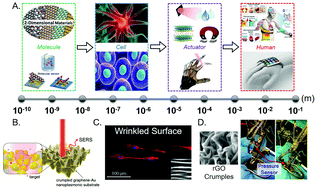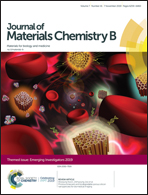Mechanochemical engineering of 2D materials for multiscale biointerfaces
Abstract
Atomically thin nanomaterials represent a unique paradigm for interfacing with biological systems due to their mechanical flexibility, exceptional interfacial area, and ease of chemical functionalization. In particular, these two-dimensional (2D) materials are able to bend, curve, and fold in response to biologically-generated forces or other external stimuli. Such origami-like folding of 2D materials into wrinkled or crumpled topographies allows them to withstand large deformations by accordion-like unfolding, with implications for stretchable and shape-changing devices. Here, we review how mechanically manipulated 2D materials can interact with biological systems across a multitude of length scales. We focus on recent work where wrinkling, crumpling, or bending of 2D materials permits new chemical and material properties, with four case studies: (i) programming biomolecular reactivity and enhanced sensing, (ii) directed adhesion and encapsulation of bacteria or mammalian cells, (iii) stimuli-responsive actuators and soft robotics, and (iv) stretchable barrier technologies and wearable human-scale sensors. Finally, we consider future directions for manufacturing, materials and systems integration, as well as biocompatibility. Taken together, these 2D materials may enable new avenues for ultrasensitive molecular detection, biomaterial scaffolds, soft machines, and wearable technologies.

- This article is part of the themed collections: Recent Review Articles and Journal of Materials Chemistry B Emerging Investigators


 Please wait while we load your content...
Please wait while we load your content...